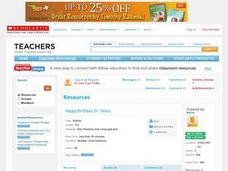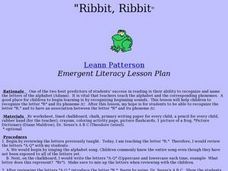Curated OER
Order! Order!
Polish organization skills in your youngsters. With this lesson, they are introduced to the trait of organization and participate in activities that reinforce organization. They cut apart a familiar story, receive different parts of the...
Curated OER
Comprehension Instructional Routine: Sequence of Events in Text
If you're looking for a detailed lesson on event sequencing from informational text, you've found it. There is an entire script for you to draw from as you explore order of events and sequence words. Scaffolding is key here; learners...
Curated OER
Sight Word Line-Up
Students use sight words to correctly line up. They are given a card and are to match it up with the set taped to the floor. They read each card and show it to the class before they move to their destination.
Curated OER
Make Words: Northern Pintail
In this language arts/science worksheet, students will focus on the words "Northern Pintail." Students will make as many words from these letters as possible and write them on the lines provided.
Benjamin Franklin Tercentenary
Learning the Printing Trade
Students explore U.S. History by reading biographical text in class. In this Benjamin Franklin instructional activity, students read about the famous American's first job and the transition he underwent from printing to politics....
Curated OER
Habitats: Cactus Hotel
A reading of Brenda Z. Guiberson’s, Cactus Hotel, launches a study of animal habitats. Working with parent volunteers or teacher aides, groups travel outside the classroom to select a habitat, take digital pictures, and incorporate the...
Curated OER
Writing Stories With Comic Strips
In this writing worksheet, students fill in a comic strip style 3 row graphic organizer to write a short story. Each row shows a starting transition word and students are instructed to include speech bubbles to show what characters are...
Curated OER
Backwards Writing: Reflections and Symmetry
Why is "ambulance" written backwards on emergency vehicles? Young geometers apply principles of symmetry to translate words written backwards. See if your school or district subscribes to Jobland, where you can view a clip that explains...
Curated OER
Happy Birthday Dr. Seuss!
Students read "Green Eggs and Ham" in celebration of Dr. Seuss's birthday and visit a storymaker website. Students create and type a three scene story using characters from Dr. Seuss's books and share their story with the class.
Curated OER
Ribbit! Ribbit!
Students research a frog's life cycle and habitat using books, the Internet and lecture. Students make origami frogs, write letters to Toad from Arnold Lobel's "Frog and Toad" and participate in a simulated camouflage activity.
Curated OER
Snowman in Winter Sequence Writing
Young scholars develop a creative snowman using step-by-step stickers. They write a short story about the snowman they have created, explaining the sequence they used to create their snowman. Students present their completed story in...
Curated OER
Sunrise Sequencing
Students examine sequencing events by discussing what they do each morning. They complete a four-panel sequence of events assignment, drawing a picture and writing a sentence for each box in the panel.
Curated OER
Lesson Ten: Direction
Students explore the concept of relative location. In this map lesson, students read I Hate English by Ellen Levine and consider how maps and globes help people to familiarize themselves with an area.
Curated OER
Animal Riddles
Students write animal riddles. They write three or more sentences describing a selected animal, and draw a picture to go with their descriptive sentences. Students then create a three slide slideshow using Kid Pix 3 computer software.















